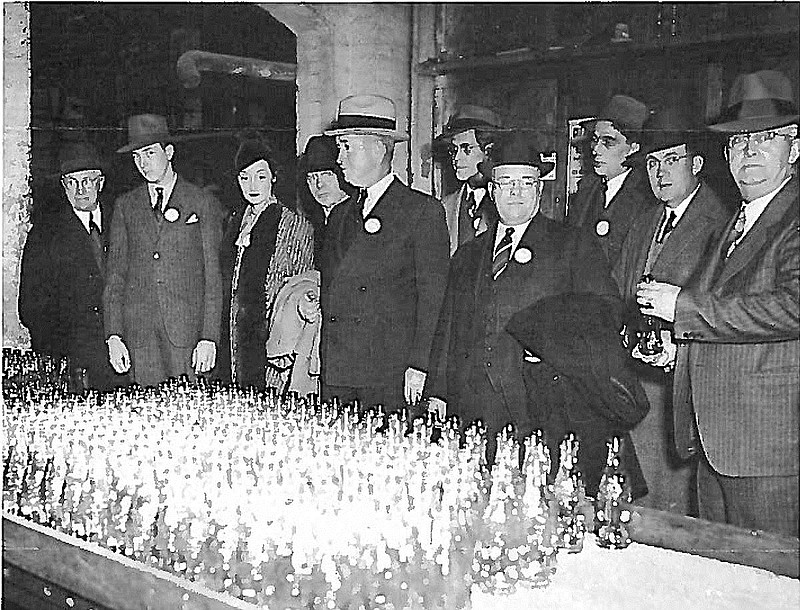A concrete slab in Alton Park holds the demolished remains of a thriving business that supplied bottles, especially for soda, throughout the South. At one time, more of the traditional contour, or hobble-skirt, Coca-Cola bottles were made there than anywhere else.
Charles Rief's Chattanooga Bottle and Glass Manufacturing Co. began making beer bottles in 1901 for his Chattanooga Brewing Co. and its original product, Liebotschaner beer. His English glass blowers at the plant soon crafted whiskey, soda and proprietary medicine bottles as well as flasks. By 1920, the Alton Park facility and a newly acquired plant in Tallapoosa, Ga., made prescription, beer, mineral, patent, proprietary and soda bottles in flint, green and amber colors.
With the advent of Prohibition in 1920, Chattanooga Bottle continued to advertise beer bottles, apparently for the latest fad: cereal beverages or near-beer.
Its main customer had become the Coca-Cola Co. although it also supplied bottles for NeHi, Nu Grape and a variety of other soft drink enterprises - as well as Mason jars for canning.
Various shapes and colors of the bottles as well as different stoppers and caps evolved over the years. In 1915-16 Coca-Cola adopted the famous hobble-skirt (contoured or curvy female profile) bottle, which gave the syrup company uniformity with its drink bottles.
Many people mistakenly credit the world-famous "father of industrial design" Robert Loewy with creating the new bottle shape. Its actual creator was the Root Glass Co. of Terra Haute, Ind., which had entered a Coca-Cola contest to create a "new and distinctive design." Many competitors in the soft drink industry were infringing on Coca-Colas trademarks and causing continuous litigation.
J. Frank Harrison, a nephew of Chattanooga Coca-Cola bottling pioneer John Thomas Lupton, bought the glass company in 1925. Harrison focused on providing bottles for Coca-Cola distributors throughout the country.
The original executive officers were J. Frank Harrison, president; W.H. Meacham, vice president and general manager; Clarence Avery, secretary, and W.T. Williford, treasurer. The name was changed to Chattanooga Glass in 1930. Harrison died in 1933. The business continued to grow.
The original glass bottles were blown by hand. The advent of automatic gas-fed furnaces greatly increased bottle production. Later, electric furnaces further upped output.
At its zenith, Chattanooga Glass Co. operated five bottle-producing furnaces on three eight-hour shifts seven days a week, employing 600 workers in the summer and 300 during the winter. Many workers carpooled from Alabama and Georgia.
Most jobs at the plant were repetitive, and the plant was not air conditioned. Rigid enforcement of safety rules came only with passage of the Occupational Safety and Health Act in 1970.
The Coca-Cola Co. in 1918 started requiring franchisees to put city/state designations on the bottom plate of the bottle showing the city of intended circulation. This mark had nothing to do with the location of the bottle manufacturer, but the presence of a town's name on the Coca-Cola bottle led to the gambling practice of "far away." Consumers would buy a coke without looking at the bottom plate. They would then make a wager for the price of the drinks or side bets as to which bottle mark was the greatest distance from place of purchase.
In 1953, J. Frank Harrison Jr. became president and Paul B. Carter chairman of the board. Five years later, Chattanooga Glass bought a second plant in Corsicana, Texas.
Charles Saylor, longtime employee and personnel manager from 1954 to 1988, recalls the various changes over the years and expresses pride that Chattanooga Glass provided employment for many blue-collar workers and support for their families.
The company adopted the practice of providing summers jobs to college students. Many of these young people attributed their desire to complete their college education to a summer of hard work at Chattanooga Glass Co.
The plant had an active intramural softball league in the summers. Various high school and college baseball players working at the plant were highly sought after by the competing league squads.
In its later years, the company went through several ownership changes and became a subsidiary of the newly formed Dorsey Corporation.
As soft drink companies switched heavily to tin cans, the Alton Park plant closed in 1988. A company with a rich history as a strong source of employment departed from the industrial fabric of Chattanooga.
Jerry Summers is an attorney with Summers, Rufolo & Rodgers. Mickey Robbins, an investment adviser with Patten and Patten, contributed to this article. For more, visit Chattahistoricalassoc.org.
